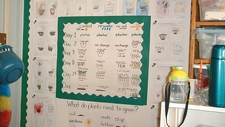Tables

TEKS Objective
The student is expected to construct maps, graphic organizers, simple tables, charts, and bar graphs using tools and current technology to organize, examine, and evaluate measured data.
Essential Understanding
The student uses scientific inquiry methods during laboratory and outdoor investigations.
Science Background
Using Graphs and Visual Data: Visionlearning (website) - Detailed information about the use and importance of visual representations (i.e., graphs and figures) for data analysis and interpretation. Includes references for further reading and additional learning modules.
Using Graphs and Visual Data
Visionlearning, www.visionlearning.com/
Organizing Information: McGraw Education (website) – Information about making and using tables are included in the article about organizing information.
Signature Lesson
Track the Weather with Weather Charts: Education.com (website) - Students conduct a three-part study to track the microclimate in their backyards, collecting data and creating representative charts and graphs on temperature, rainfall, and observed weather. By organizing, examining and evaluating the data, students will learn about local temperature trends and rainfall frequency.
Track the Weather with Weather Charts
by Erica Loop, Education.com
- Supporting Lessons
- Extensions
- Assessment Ideas
- Literature Connections
- Related
TEKS - Additional Resources
Supporting Lessons
Impact Craters: NASA (PDF) - Impact craters are formed when impactors, such as meteorites, smash into the moon’s surface. In this activity, students use “impactors” of different masses (marbles, ball bearings, etc.) to study the relationship of an impactor’s velocity to crater size. Students construct graphs, tables and charts to represent and evaluate the data collected.
Elaboration Lessons and Extensions
Learning to Make Data Tables: SEDL (PDF) – A tutorial for students on how to make a data table. Examples are provided.
Assessment Ideas
Experiment with Fat: HowToSmile.org (website) – Students determine the fat content in foods using brown paper bags and then display and organize their data with a table. To complete a thorough assessment, students can create their own tables (with guided help) instead of filling in the provided chart. Click the green “Go to Activity” link to obtain the lesson plan.
Literature Connections
Great Tables, Graphs, Charts, Diagrams & Timelines You Can Make. Zike, Dinah (ISBN-13: 978-1882796144)
Beginning Charts, Graphs & Diagrams. Carratello, Patty (ISBN-13: 978-1557341686)
Additional Resources
Representing Data, Introduction: KS3 Bitesize/BBC (website) - Links to information on creating and understanding different types of graphs or charts used to organize and represent scientific data: bar charts, line graphs, pictograms, pie charts, frequency diagrams and scatter diagrams.
Representing Data, Introduction
KS3 Bitesize/BBC, www.bbc.co.uk
Analyze Data and Draw Conclusions: Discovery Education (website) – Practice analyzing data on a sample table filled with data on plant height and number of leaves.
Analyze Data and Draw Conclusions
Discovery Education, school.discoveryeducation.com
TEKS Navigation
Grade 3
Need Assistance?
If you need help or have a question please use the links below to help resolve your problem.

Comments